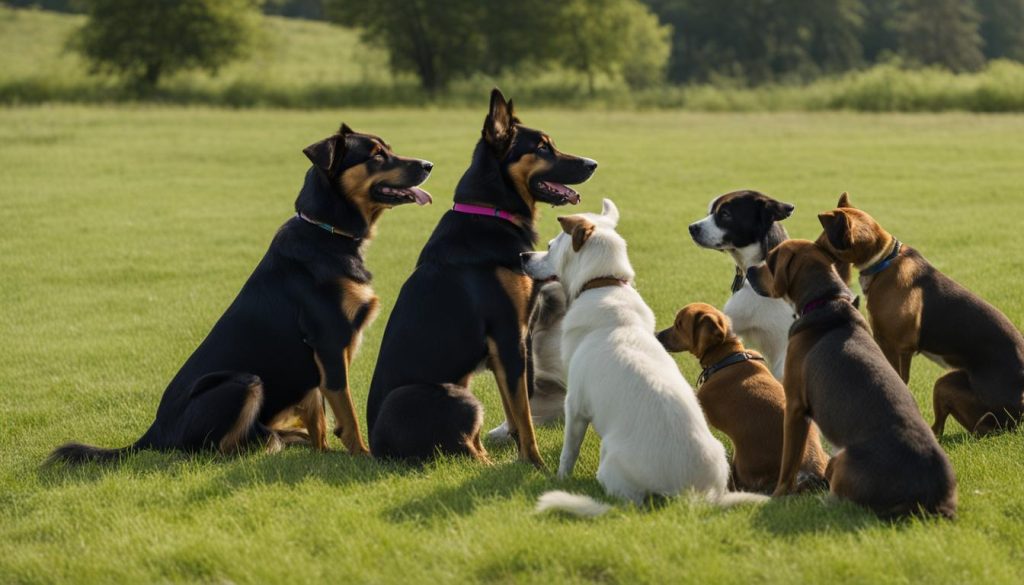As a professional journalist, I seek to provide accurate information on various topics related to pets. In this article, we will explore the mating behavior and reproductive abilities of neutered dogs. One common question that pet owners often ask is whether a neutered dog can still lock with a female. Let’s delve into this topic to shed light on the facts.
Key Takeaways:
- Neutered male dogs cannot impregnate female dogs due to the removal of the testicles and their reproductive structures.
- While there is a small possibility of pregnancy immediately after neutering, a neutered dog’s reproductive abilities diminish over time.
- Neutered dogs have reduced mating instincts and desire to mate.
- Spaying female dogs eliminates their ability to attract intact males and prevents unwanted pregnancies.
- Neutering has numerous health and behavioral benefits and aids in controlling the pet population.
The Neutering Procedure

When a dog is neutered, it undergoes a surgical procedure known as castration, which involves the removal of the testicles and their associated structures. This procedure is performed to eliminate the dog’s ability to produce sperm and impregnate female dogs. The neutering procedure is commonly carried out to control the pet population and prevent unwanted pregnancies.
The castration process not only renders the male dog infertile but also alters its hormonal balance. Testosterone, the hormone responsible for driving sexual behaviors, is significantly reduced after neutering. This reduction in hormone levels can help reduce or eliminate certain mating behaviors such as marking territory, roaming, and aggression.
Please be aware that the neutering procedure should only be performed by a qualified veterinarian under sterile conditions. The surgical incision is typically made in the scrotum, and the testicles are carefully removed. The dog is then monitored during the recovery period to ensure proper healing and to prevent any complications.
| Advantages of Neutering | Disadvantages of Neutering |
|---|---|
| Prevents unwanted pregnancies | Requires anesthesia and surgical procedure |
| Reduces the risk of certain reproductive-related diseases | Potential for post-surgical complications |
| Helps control overpopulation of pets | May affect the dog’s metabolism and weight |
| Reduces the likelihood of aggressive behavior | Can alter the dog’s coat texture or color |
Overall, the neutering procedure is an effective and safe method of preventing reproduction in male dogs. It not only eliminates the dog’s ability to impregnate female dogs but also helps reduce certain mating behaviors and prevent the development of reproductive diseases. However, it is important to consult with a veterinarian to determine if neutering is the right choice for your dog and to ensure that the procedure is performed under the appropriate conditions.
Can Neutered Dogs Still Mate?
The sexual behavior of neutered dogs is a topic of interest for many pet owners. Can neutered dogs still mate? While neutered dogs are physically capable of mating, the neutering procedure removes the testicles, which are responsible for producing sperm. Without sperm, a neutered dog is unable to fertilize a female dog’s eggs and sire any litters. Neutering also reduces the hormones that drive mating instincts, resulting in a decreased desire to mate.
It is important to note that neutering does not completely eliminate all behaviors associated with mating. Some neutered dogs may still exhibit mounting or humping behaviors, although these are often unrelated to reproduction. These behaviors can be influenced by other factors such as dominance, anxiety, or social cues from other dogs. However, it is essential to understand that these behaviors are not driven by the dog’s reproductive hormones.
Spayed male dogs, on the other hand, do not possess the sexual behavior commonly associated with intact males. The removal of the testicles eliminates the production of testosterone, which significantly reduces the male dog’s desire to mate. While some neutered male dogs may still display mounting or humping behaviors, they are typically nonsexual in nature and are more related to social interactions or play.
In summary, although neutered dogs are physically able to mate, the neutering procedure renders them infertile by removing their testicles and reducing their reproductive hormones. Neutering also decreases the desire to mate, although some nonsexual mounting or humping behaviors may still be observed. It is important to consult with a veterinarian for further guidance on the sexual behavior of neutered dogs and responsible pet ownership.
| Q: Can neutered dogs still mate? | A: No, neutered dogs are unable to fertilize a female dog’s eggs due to the removal of the testicles. |
|---|---|
| Q: Do neutered dogs exhibit mating instincts? | A: Neutering reduces the hormones that drive mating instincts, resulting in a decreased desire to mate. |
| Q: How do neutered male dogs behave? | A: Neutered male dogs do not possess the sexual behavior commonly associated with intact males. Their desire to mate is significantly reduced. |
| Q: Can neutered dogs still exhibit mounting or humping behaviors? | A: Some neutered dogs may still display mounting or humping behaviors, but these are typically nonsexual in nature and are influenced by factors other than reproduction. |
The Reproductive Abilities of Neutered Dogs

Neutering a male dog significantly impacts its reproductive abilities. The procedure involves the removal of the testicles, which are responsible for producing sperm. As a result, neutered dogs are unable to impregnate female dogs or father any litters. While there may still be some residual hormonal activity immediately after the surgery, this diminishes over time, and the dog becomes infertile.
It is important to note that neutered dogs may still exhibit mating behaviors, such as mounting or humping. However, these behaviors are usually unrelated to reproduction and more likely driven by other factors, such as dominance or learned behaviors. Neutering reduces the hormones that drive mating instincts, resulting in a decreased desire to mate. This helps prevent unwanted pregnancies and contributes to controlling the pet population.
The Breeding Potential of Neutered Male Dogs
Once a male dog is neutered, its breeding potential is eliminated. Neutering removes the ability to produce sperm, making it impossible for the dog to father any litters. The dog’s reproductive capabilities diminish gradually, and over time it becomes infertile.
Neutering male dogs also helps improve their overall health. It reduces the risk of certain reproductive-related issues, such as testicular cancer and prostate problems. Neutered dogs are generally calmer and less prone to aggression, as the procedure eliminates the hormonal influences that can contribute to such behaviors.
| Benefits of Neutering Male Dogs | Risks of Not Neutering Male Dogs |
|---|---|
|
|
Spaying Female Dogs and Attracting Intact Males

When a female dog is spayed, her ability to attract intact males is greatly diminished. Spaying removes the ovaries and uterus, eliminating the hormones responsible for heat cycles and mating behaviors. As a result, a spayed dog no longer emits the scent signals that typically attract intact males during her heat cycle. This reduces the likelihood of attracting mating partners and significantly decreases the chances of unplanned pregnancies.
While a neutered male dog may still attempt to mate with a spayed female dog, it is important to note that the female’s lack of reproductive organs makes it impossible for her to become pregnant. Without a uterus, there is no possibility for fertilization to occur. Therefore, spaying provides a reliable and effective method of preventing unwanted litters and ensuring responsible pet ownership.
It’s important to understand that the impact of spaying on mating behaviors goes beyond the physical changes. By eliminating the heat cycles and hormonal fluctuations associated with reproduction, spaying can also help reduce certain behavioral issues that may arise from mating instincts. Spayed female dogs are less likely to exhibit behaviors such as restlessness, vocalization, and attempts to escape in search of a mate. This can lead to a calmer and more balanced temperament in the spayed dog, contributing to a harmonious and stress-free living environment for both the dog and its owner.
The Myth of Neutered Dogs’ Ability to Lock
There is a common misconception surrounding the ability of neutered dogs to “lock” with a female during mating. However, this belief is entirely unfounded. Neutering, which involves the removal of the testicles, alters the anatomy of a male dog’s reproductive system, making locking physically impossible. This myth may have originated from the fact that intact male dogs often lock during mating due to the engorgement of their penis, which can cause them to remain connected to the female for a period of time. However, once a dog has been neutered, this physiological response is no longer possible.
Neutering is a surgical procedure that permanently removes the testicles, eliminating the production of sperm. Without sperm, a neutered dog cannot fertilize a female dog’s eggs and sire any litters. Additionally, neutering reduces the hormones that drive mating instincts, resulting in a decreased desire to engage in sexual behaviors. While some neutered dogs may exhibit mounting or humping behaviors, these actions are often unrelated to reproduction and are instead driven by other factors such as dominance or arousal.
It’s important to dispel the myth of neutered dogs’ ability to lock to ensure that pet owners have accurate information about the reproductive abilities of their pets. Neutering is an effective method for preventing unwanted pregnancies and controlling the pet population. It also offers various health and behavioral benefits for both male and female dogs. By separating fact from fiction, we can make informed decisions about the responsible care and management of our beloved pets.
The Best Age to Neuter a Dog

When it comes to neutering dogs, timing is crucial to ensure both behavioral and health benefits. The American Society for the Prevention of Cruelty to Animals (ASPCA) recommends neutering male dogs between six to nine months of age. However, neutering can be performed as early as eight weeks for puppies in good health. Consulting with a veterinarian is essential to determine the best age for neutering based on the individual dog’s circumstances.
Neutering at a young age has several advantages. It helps prevent unwanted litters, reduces the risk of certain reproductive-related health issues, and can positively impact behavior. Neutered male dogs are generally calmer and less prone to aggression. Additionally, early neutering eliminates the risk of testicular cancer and reduces the incidence of prostate disease.
On the other hand, waiting until the dog is fully matured to neuter may have potential benefits as well. Some studies suggest that delaying neutering until after the dog has reached sexual maturity may promote better musculoskeletal development, especially in larger breeds. However, this approach should be carefully considered, as it increases the risk of unwanted litters and doesn’t provide the same behavioral and health benefits as early neutering.
| Advantages of Early Neutering (6-9 months) | Advantages of Delayed Neutering (fully matured) |
|---|---|
|
|
Ultimately, the decision on the best age to neuter a dog should be made in consultation with a veterinarian. They will assess the individual dog’s breed, size, health, and behavior to determine the most appropriate timing for the procedure. Neutering is an essential aspect of responsible pet ownership, helping to control the pet population and ensure the overall well-being of dogs.
Considerations for Spaying or Neutering Your Pet

Spaying and neutering procedures are highly recommended for pet owners due to their numerous benefits. Not only do these procedures help control the pet population, but they also improve the overall health and behavior of dogs. By removing the reproductive organs, spaying and neutering eliminate the risk of unwanted litters, preventing further strain on animal shelters and reducing the number of homeless animals.
Spaying female dogs, in particular, offers significant advantages. The procedure removes the ovaries and uterus, effectively eliminating heat cycles and the associated behavioral and physical changes that come with them. Spayed females are less likely to wander in search of a mate, reducing the risk of accidents and injuries. Additionally, spaying can greatly reduce the incidence of certain reproductive-related health issues, such as uterine infections and certain types of cancer.
Neutering male dogs also provides numerous benefits. By removing the testicles, neutering significantly reduces the production of testosterone, a hormone responsible for driving mating behaviors. This can result in a calmer and more focused demeanor, making it easier to manage and train the dog. Neutered males are also less likely to engage in certain undesirable behaviors, such as marking territory or displaying aggression. Furthermore, neutering can help prevent reproductive-related health issues in males, such as testicular cancer.
Overall, spaying and neutering are vital for responsible pet ownership. These procedures not only help control the pet population but also improve the health and behavior of dogs. Consult with a veterinarian to determine the best age for spaying or neutering your pet, considering the individual circumstances and health of the dog. By opting for spaying or neutering, you are making a positive impact by ensuring a healthier, happier life for your beloved pet.
Neutering and Sexual Behavior in Dogs

When it comes to neutered dogs, it’s important to understand that the procedure can have an impact on their sexual behavior, although it may not eliminate all behaviors associated with mating. While neutering removes the testicles and reduces the production of sperm, some neutered dogs may still exhibit mounting or humping behaviors. It’s worth noting that these behaviors are often unrelated to reproduction and can stem from other factors such as dominance or excitement.
Neutering should not be seen as a guaranteed solution to correct all behavioral issues in dogs. It is, however, a crucial aspect of responsible pet ownership that helps control the pet population and reduces the risk of unwanted litters. The primary purpose of neutering is to prevent a male dog from impregnating a female dog and fathering litters. By removing the testicles and altering the reproductive system’s anatomy, neutering makes the physical act of mating, including locking or tying, impossible for the male dog.
It’s essential to recognize that neutering is not solely about curbing sexual behaviors. The procedure also offers various health and behavioral benefits for dogs. Neutered males tend to be calmer and less prone to certain reproductive-related issues, such as testicular cancer and prostate problems. Additionally, neutering helps reduce the risk of roaming, aggression, and urine marking behavior in male dogs. It is always advisable to consult with a veterinarian to determine the best age and timing for neutering based on the individual dog’s circumstances.
Comparing Sexual Behaviors of Intact and Neutered Dogs
| Behavior | Intact Male | Neutered Male |
|---|---|---|
| Mounting | Predominant behavior, driven by reproductive instincts | May still occur but often unrelated to reproduction |
| Humping | Common behavior, can be related to mating or dominance | May persist but often unrelated to reproduction |
| Roaming | More likely to wander in search of females | Reduced tendency to roam |
| Aggression | Can be more territorial or aggressive towards other males | Reduced aggression towards other males |
| Urine Marking | Increased likelihood of marking territory with urine | Reduced tendency to mark with urine |
While neutering can have a positive impact on sexual behaviors in dogs, it should be understood that every dog is unique. Some dogs may experience more significant behavior changes following neutering, while others may display minimal changes. Overall, neutering remains an important aspect of responsible pet ownership and plays a crucial role in managing the pet population and improving the overall health and behavior of dogs.
Wrapping Up
Neutered dogs, after undergoing the removal of their testicles, are no longer capable of impregnating female dogs and cannot father any litters. This procedure greatly reduces the production of sperm and diminishes the drive to mate. While some mating behaviors may still be present in neutered dogs, the risk of unwanted pregnancies is significantly diminished.
Spaying and neutering play a crucial role in controlling the pet population and improving the overall health and behavior of dogs. These procedures have a profound impact on reproduction, preventing unwanted litters and reducing the number of homeless animals. By removing the reproductive organs responsible for heat cycles and mating behaviors, spayed female dogs are less likely to attract intact males and cannot become pregnant.
It is important to note that neutering does not guarantee the complete elimination of all mating-related behaviors. Despite the removal of the testicles, some neutered dogs may still exhibit mounting or humping behaviors, although these actions are typically unrelated to reproduction. Therefore, while neutering is beneficial for many reasons, it should be viewed as one aspect of responsible pet ownership and not a guaranteed solution for correcting all behavioral issues.
FAQ
Can a neutered dog still lock with a female?
No, neutering removes the testicles and alters the anatomy of the male dog’s reproductive system, making locking impossible.
What is the neutering procedure?
Neutering, also known as castration, is the surgical removal of the testicles and their respective structures to prevent male dogs from reproducing.
Can neutered dogs still mate?
Neutered dogs are physically capable of mating, but they no longer have the reproductive abilities to impregnate female dogs. Neutering also reduces the hormones that drive mating instincts, resulting in a decreased desire to mate.
What are the reproductive abilities of neutered dogs?
Neutered dogs cannot impregnate female dogs and cannot sire any litters. The neutering procedure removes the testicles, reducing the production of sperm and the drive to mate.
Can a spayed dog still attract intact males?
No, spaying removes the ovaries and uterus, eliminating the hormones responsible for heat cycles and mating behaviors. A spayed female dog is unable to become pregnant.
Is it true that neutered dogs can still lock with a female?
No, this is a myth. Neutering removes the testicles and alters the male dog’s reproductive anatomy, making locking impossible.
What is the best age to neuter a dog?
The American Society for the Prevention of Cruelty to Animals (ASPCA) recommends neutering male dogs between six to nine months of age, but it can be performed as early as eight weeks old for puppies in good health. The timing is crucial for maximum behavioral and health benefits.
Why is spaying or neutering important for pets?
Spaying and neutering procedures are strongly recommended by veterinarians to control the pet population and reduce the number of homeless animals. They also prevent unwanted litters and can have various health and behavioral benefits.
How does neutering affect sexual behavior in dogs?
Neutering can reduce sexual behaviors in dogs, but it may not entirely eliminate all behaviors associated with mating. Some neutered dogs may still exhibit mounting or humping behaviors, although these are often unrelated to reproduction.
Is neutering a guaranteed solution for correcting all behavioral issues?
Neutering should not be seen as a guaranteed solution to correct all behavioral issues, but rather as a part of responsible pet ownership. It can help reduce certain behaviors associated with mating, but other training and behavioral interventions may be necessary for specific issues.






